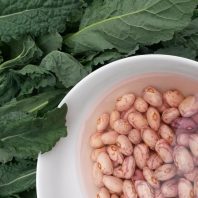Today we were transplanting over 1000 kale seedlings at Tolhurst Farm. We ripped off the top leaves so the plants won’t transpire too much*. The baby leaves were way too good to throw away. By chance I had some of the farm’s borlotti beans soaking: yes! Tuscan bean soup tonight. Traditionally it would be a cavolo nero kale but any will do. You may need to cut out the chunky midrib of the leaf. Best of all, grow your own and pick it tender and fresh.
Normally we think of this as a hearty autumn dish, but if you have beans in store (and those who know the Squash and Bean Swap, know the love of growing beans for drying), and new leafage full of prana and the joy of spring, go for it. Add in the farm’s organic parsley and carrots, also a handful of fresh peas…so tasty.
This is a simplified yogi (no onion/garlic), vegan (no animal stock, parmesan sprinkle) version of an Italian ‘peasant’ classic.
3- 4 servings
Ingredients
- 125g of dried borlotti beans, soaked overnight in cold water
- 1 tbsp olive oil, plus a glug for adding at the end
- c. 200g (two medium) carrots in quarter slices
- c 200g chopped celery and/or bulb fennel (I had neither, so upped the parsley, botanically related to both)
- a tin of chopped tomatoes (lovely if you can get home bottled, though). Fresh is ok but use cooking aka plum tomatoes; Italians call them ‘pelati’, literally peeled. Tolhurst is growing ‘Quadro’ for it’s tomato sauce range. ‘San Marzano’ is the classic variety that does ok in the UK.
- big pinch each of sea salt and fresh ground black pepper
- 100g ditalini pasta, or other small pasta shapes (I only had big, but that’s fine)
- c 300g kale roughly chopped
- a big handful of flat leaf Italian parsley, chopped
- juice of half a lemon
Method
- Put soaked beans in a pan and cover with cold water – three times the volume. Bring to the boil and boil hard for at least 10 minutes. half cover and simmer for another 45 – 60 minutes. How long they take depends on how fresh they are. When you can squash one easily between finger and thumb, and the inside looks floury, drain them and put to the side for the moment.
- Heat the tbsp oil and fry off the carrots and celery/fennel. Add in the beans, coat with oil and stir them around. Add in the pelati, salt, pepper and around 300ml boiled water. Have the heat high for a couple of minutes, then simmer for another 20 or so. After 15 minutes add in the pasta.
- Add in the kale and cook for another 5-10 minutes or so, depending on its tenderness.
- Turn off the heat. Add in the parsley and lemon juice. Stir.
- Serve, adding a swirl of oil to the bowl, with a nice crusty sourdough loaf.
Nutrition notes
The bread I had was stale (but still good) so I made chunky croutons in rape seed oil, just to vary the oil types. I didn’t want more oil in the soup (though a good olive oil is all part of the taste conglomeration), and rape seed is high in omega 3, while olive is high in omega 6. Too confusing about 3:6:9 ratios etc. Just have some sometimes! It was a seven grain sourdough loaf from Aston’s organic bakery, that supply the Tolhurst box scheme.
Kale is high in folate and other key B vitamins, as well as vitamin K. Beans are also high in folate, and of course super duper protein bombs! Have this info up your sleeve for the tedious naysayers of a vegan diet.
Parsley is an excellent source of vitamin C and and a good source of A and definitely worth more than a garnish. Add fresh herbs after cooking so that the health giving compounds are retained. Lemon juice not only enhances flavour, but also alkalises the blood, meaning that oxygen is carried more readily, and your tissues are more vital.
Buon appetito!
*Transpiration: the movement of water through the plant, from roots up and out through stomata (microscopic holes on the underside of the leaves). When transplanting you want to limit transpiration as it requires energy from the plant and we want the plant to concentrate its energy to make a good root structure. Plants often drop their leaves on being transplanted anyway. Once the roots are established, new leaves come in.
